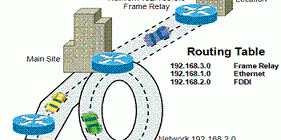Network and Node Addresses
Each network segment between routers is is identified by a network address. These addresses contain information about the path used by the router to pass packets from a source to a destination.
For some network layer protocols, a network administrator assigns network addresses according to some preconceived internetwork addressing plan. For other network layer protocols, assigning addresses is partially or completely dynamic.
Most network protocol addressing schemes also use some form of a node address. The node address refers to the device’s port on the network. The figure in this slide shows three nodes sharing network address 1 (Router 1.1, PC 1.2, and PC 1.3). For LANs, this port or device address can reflect the real Media Access Control or MAC address of the device.
Unlike a MAC address that has a preestablished and usually fixed relationship to a device, a network address contains a logical relationship within the network topology.
The hierarchy of Layer 3 addresses across the entire internetwork improves the use of bandwidth by preventing unnecessary broadcasts. Broadcasts invoke unnecessary process overhead and waste capacity on any devices or links that do not need to receive the broadcast. By using consistent end-to-end addressing to represent the path of media connections, the network layer can find a path to the destination without unnecessarily burdening the devices or links on the internetwork with broadcasts.
Examples:-
For TCP/IP, dotted decimal numbers show a network part and a host part. Network 10 uses the first of the four numbers as the network part and the last three numbers—8.2.48-as a host address. The mask is a companion number to the IP address. It communicates to the router the part of the number to interpret as the network number and identifies the remainder available for host addresses inside that network.
For Novell IPX, the network address 1aceb0b is a hexadecimal (base 16) number that cannot exceed a fixed maximum number of digits. The host address 0000.0c00.6e25 (also a hexadecimal number) is a fixed 48 bits long. This host address derives automatically from information in the hardware of the specific LAN device.
Subnetwork Addressing
Subnetworks or subnets are networks arbitrarily segmented by a network administrator in order to provide a multilevel, hierarchical routing structure while shielding the subnetwork from the addressing complexity of attached networks.
Subnetting allows single routing entries to refer either to the larger block or to its individual constituents. This permits a single, general routing entry to be used through most of the Internet, more specific routes only being required for routers in the subnetted block.
A subnet mask is a 32-bit number that determines how an IP address is split into network and host portions, on a bitwise basis. For example, 131.108.0.0 is a standard Class B subnet mask; the first two bytes identify the network and the last two bytes identify the host.
A subnet mask is a 32-bit address mask used in IP to indicate the bits of an IP address that are being used for the subnet address. Sometimes referred to simply as mask. The term mask derives from the fact that the non-host portions of the IP address bits are masked by 0’s to form the subnet mask.
Subnetting helps to organize the network, allows rules to be developed and applied to the network, and provides security and shielding. Subnetting also enables scalability by controlling the size of links to a logical grouping of nodes that have reason to communicate with each other (such as within Human Resources, R&D, or Manufacturing).
Routing Algorithm Types
Routing algorithms can be classified by type. Key differentiators include:
– Single-path versus multi-path: Multi-path routing algorithms support multiple paths to the same destination and permit traffic multiplexing over multiple lines. Multi-path routing algorithms can provide better throughput and reliability.
– Flat versus hierarchical: In a flat routing system, the routers are peers of all others. In a hierarchical routing system, some routers form what amounts to a routing backbone. In hierarchical systems, some routers in a given domain can communicate with routers in other domains, while others can communicate only with routers in their own domain.
– Host-intelligent versus router-intelligent: In host-intelligent routing algorithms, the source end- node determines the entire route and routers act simply as store-and-forward devices. In router- intelligent routing algorithms, host are assumed to know nothing about routes and routers determine the optimal path.
– Intradomain versus interdomain: Some routing algorithms work only within domains; others work within and between domains.
– Static versus dynamic – this classification will be discussed in the following two slides.
– Link state versus distance vector: will be discussed after static versus dynamic routing.

